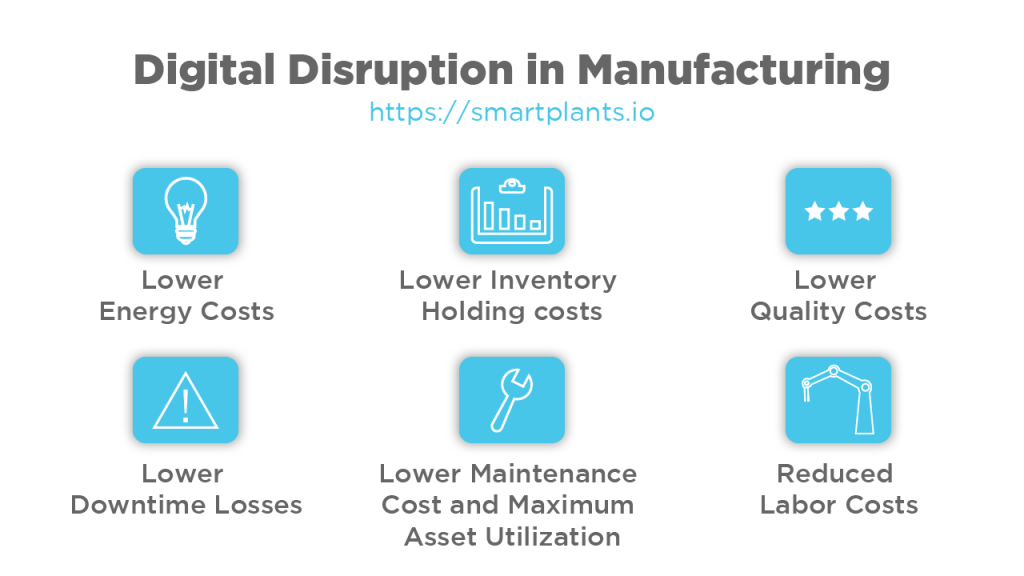
Running a factory is expensive. And that’s the understatement of the year. From direct labor to supply materials to all the several components of manufacturing overheads. Every component has a bulk of cost attached to it. In both batch and assembly production. For example inventory holding alone could cost upto 25% of the production budget, depending on the type of factory. While spending money is a given in this business, becoming lean is a crucial and continuous process in every manufacturing firm. The problem is very ripe for disruption. Luckily, the solutions are already here and are here to stay.
Smart Factory Responsible for Digital Disruption in Manufacturing
A study by Fujitsu in May 2017 reported that digital disruption is the “new normal” in the manufacturing sector because it is redefining the way organisations operate. This digitization in the manufacturing industry has come through smart factories. A solution that is powered by Internet of Things and smart robotics.
Three-quarters (76%) of manufacturers are either formulating a smart factory initiative or already have one in place, based on the findings of CapGemini. While tech articles and news pieces are driving you crazy by declaring the exciting cutting-edge benefits of a smart factory like a broken record, below are 6 ways that show how digital disruption by a smart factory can immediately help you cut manufacturing costs dramatically. An amount that can be reinvested or utilized for other rewarding ventures or even make your business financially self-reliant.

1. Lower Energy Costs
The largest saving made by digital disruption in your factory setup would without a doubt be energy costs. The biggest advantage of having a visual monitor of the entire manufacturing process down to the micro-level, means that you can take quick and effective actions to make your factory leaner and leaner. This means highest possible uptime, or optimum production. And zero energy and money wasted on unnecessary downtime.
A recent factory upgraded by Smart Plants resulted in 7.5% increase in their net production worth, in just a matter of three months! Which translates to around 10 million Euro in hard numbers. That’s the net result of increased revenue from higher uptime plus the savings made from eliminated energy wasting activities
2. Lower Inventory Holding costs
Surprisingly enough, businesses merely estimate inventory costs when calculating total manufacturing costs. The exact costs of holding and maintaining the inventory are often ignored. These include taxes, inventory service costs, insurance, value depreciation etc. In earlier days companies used to estimate inventory to amount to 25% of the net production cost. Which, even as a rough estimate, is a fairly large part.
One of the ideals behind digital disruption is the power to visualize the otherwise hidden data, in a useful form through transformations and analytics. A smart factory solution like the one by Smart Plants, provides a detailed real time overview of your factory. It implies the use of user friendly dashboards with real time analytics. Thankfully, it can easily be enabled on inventory factions as well. Once all inventory is part of the connected network, the smart factory application can help you visualize, simplify and streamline even the most resource-intensive process. So no part is ever over-ordered or run out of. And no part is stored for long unnecessarily
3. Lower Quality Costs
Quality checks are the pesky, time (and hence money) consuming hurdles required at every stage of production. Since Smart Factory works in real time, our web app users have a powerful capability to view live operation details and save manual time costs. The users can even “rewind” to a certain point in any connected machine’s performance history. The high level of intelligence provided by Smart Factory dashboards means quality officers can dramatically improve root cause analysis for their companies. They can proactively prevent quarantines and production mistakes occurring in the first place. Which cost a fortune to remedy.
4. Lower Downtime Losses
Downtime is exponentially proportional to money loss. One hour of downtime can cost from $100,000 to $1,000,000 depending on the size of the factory and how critical the bottleneck was. And the downtime caused by these bottlenecks are carried way downstream, to the end of the assembly line. One of our customers’ results proved that one hour less downtime of a bottleneck machine, is equivalent to one hour less downtime for the whole production. They had implied the use of easy-to-understand dashboards displaying machines’ status in our solution, to mitigate their downtime. However, despite the great results, the finding is economically disastrous if downtime increases and is not efficiently mitigated.
5. Lower Maintenance Cost and Maximum Asset Utilization
Some interruptions in manufacturing can often take days to locate and diagnose. By which time the bottleneck equipment or machine is irreparable and needs a costly replacement. A major advantage of immediate alerts by the digital system, is that bottlenecks are identified instantly. It means corrective action can be taken more quickly. And the costly rip-and-replace can be avoided.
6. Reduced Labor Costs
Getting the job done does not necessarily require utilizing the entire workforce capacity. A demand-based work order formed by the help of historic trend reports and KPIs in the smart factory solution, will allow you to see which parts of the production process require worker input and just how much. Labor costs agreeably make the highest portions of manufacturing expenditures. However, digital disruption allows you to optimize it by allocating only the required number of personnel for given amounts of time, and redistributing personnel over different jobs. This, will not only reduce overtime expenses for you but also help save a huge chunk of extra labor costs.
Such tried and tested results make the decision of installing a smart factory solution a no-brainer. Needless to say the production cost savings with a smart factory solution will most definitely outweigh the initial investment by a humongous margin. In the end, each company has to prioritize improvement projects to meet customer demand for quality and quantity, and maintain their competitive edge in this increasingly disruptive and fast paced era.
